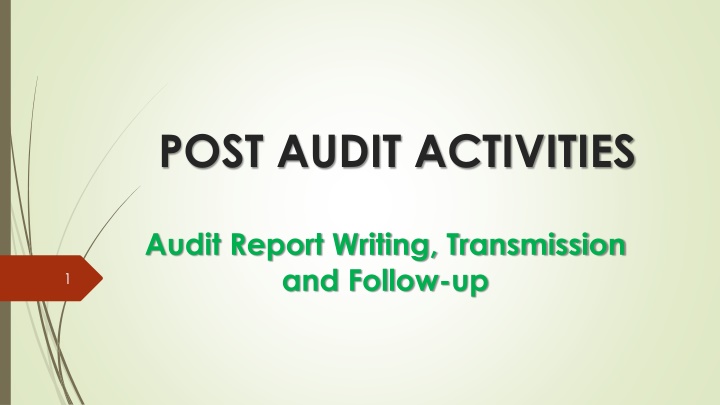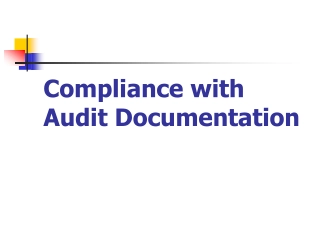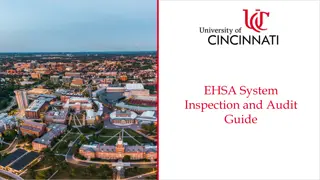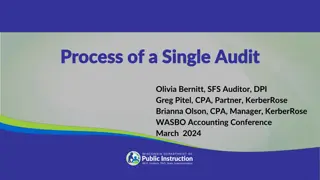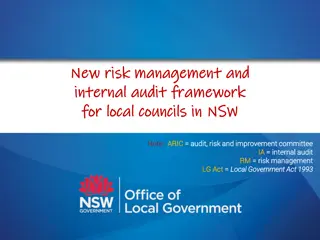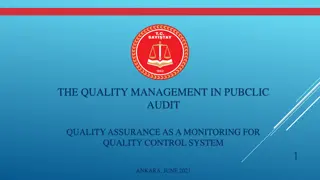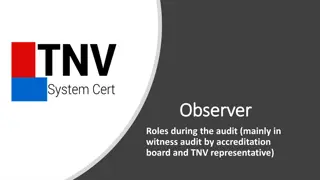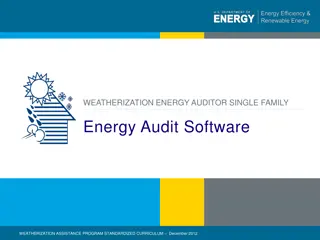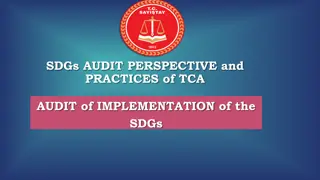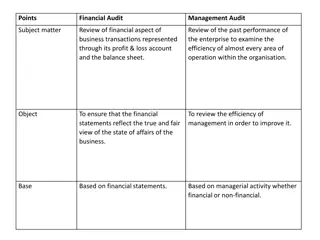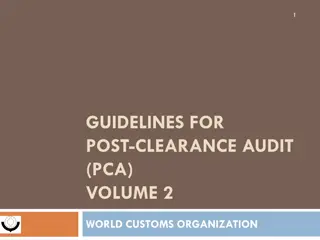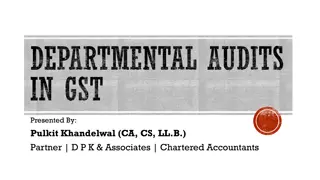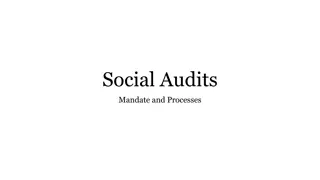Post-Audit Activities: Report Writing & Follow-up
This content covers post-audit activities, report writing, transmission, and follow-up processes in detail. Learn about audit reports, their importance, and drafting procedures for effective communication with stakeholders.
Download Presentation

Please find below an Image/Link to download the presentation.
The content on the website is provided AS IS for your information and personal use only. It may not be sold, licensed, or shared on other websites without obtaining consent from the author.If you encounter any issues during the download, it is possible that the publisher has removed the file from their server.
You are allowed to download the files provided on this website for personal or commercial use, subject to the condition that they are used lawfully. All files are the property of their respective owners.
The content on the website is provided AS IS for your information and personal use only. It may not be sold, licensed, or shared on other websites without obtaining consent from the author.
E N D
Presentation Transcript
POST AUDIT ACTIVITIES Audit Report Writing, Transmission and Follow-up 1
Module Objectives 2 By the end of the module the Trainee should be able to: Review inspection outcomes Distinguish between inspection/audit findings and observations Write an inspection report Fill Corrective Action Request forms Transmit an audit report Evaluate the ANSPs Corrective Action Plans Follow up on CAP implementation
What is a Report 3 A report is a document that presents information in an organized format for a specific audience and purpose. It gives an account of something that one has observed, heard, done, or investigated. The report is meant to achieve an organizational purpose of: Informing Putting in record, and/or Requiring action
Post Audit Activities 4 After physical or virtual surveillance, audit teams conduct a post-audit meeting to consolidate and analyze data. Once conclusions have been drawn, audit teams are expected to conduct a validation meeting with the Head of the inspectorate and finally to complete and submit an audit report to the ANSP(s). Post audit activities include: collating and analyzing data collected from all audited facilities and services; validating observations; writing and submitting an audit report; archiving audit records; and follow-up with the ANSP(s).
Audit Report 5 A document that summarizes the results of an audit It gives a factual account of the audit Highlights observations made and if applicable recommendations Prepared by the team leader in coordination with team members Should be approved by the head of inspectorate (as applicable) before submission to ANSP
Draft Audit Report 6 Serves as a post-audit brief detailing findings and recommendations Also serves as an advance notification for the ANSP to submit Corrective Action Plans Used to verify findings/observations made during the exit meeting
Audit Report 7 The final audit report is an objective reflection of the audit It details the audit process and summary of identified deficiencies Written to formalize audit findings and request for corrective action by the ANSP Should be clear, concise and contain facts presented and agreed upon at the exit meeting
Audit Report Writing 8 Commences immediately after the exit meeting The Team Leader consolidates contributions from Team Members. The TL should review, coordinate and discuss with Team members of their individual submissions This ensures the overall quality and consistency of the report.
Audit Report 9 An audit report should objective and not contain: Subjective opinions Criticism Observation not discussed at the exit meeting Confidential information Trivial issues
Audit Report 10 As part of the production of the audit draft report, the TL performs a technical review of the audit results and the information contained in the audit draft report, including the: evidence collected by the audit team; and findings issued by the audit team. recommendations of the TMs
Findings 11 Generated as a result of an audit to point to non- compliance with safety related provisions of: state regulations ICAO annexes Technical Guidance Material Good aviation safety practices Non development of a required document/manual
Classification/Level of Findings 12 Findings are classified according to their possible effect on air safety Inspectors should therefore evaluate the effect of each finding on safety Deficiencies posing imminent safety risk must receive immediate attention If safety is/will be compromised by continued existence of a deficiency, then action should be taken to suspend operations
Classification of Findings 13 Findings can be classified in three classes namely: Serious Finding (Level I) Major Deficiency (Level II) Minor Deficiency (Level III)
Serious Finding (Level I) 14 A deficiency posing a very serious safety risk to aviation safety Requires immediate action by the ANSP to resolve it Involves imposition of operating restrictions till the safety concern has been addressed or resolved No certificate/licence or authorization should be issued or renewed till the deficiency is resolved or eliminated.
Major Deficiency (Level II) 15 A deficiency in the service provider s system and posing a serious safety risk which should be resolved within 10 days Requires a CAP from the ANSP detailing plans and timelines to resolve the deficiency The Authority can impose operating restrictions to ensure the ANSP resolves the deficiency Certificate/licence/authorization action till an acceptable CAP is received is an example of operating restrictions
Minor Deficiency (Level III) 16 A non-compliance that could lower safety standards Poses less serious safety risk and concerns isolated incidents which will not necessarily have a direct impact on safety on its own Required development of a CAP by the ANSP with a maximum implementation period of 90 days A certificate/licence/authorization may be issued/renewed subject to submission of an acceptable CAP by the ANSP
Minor Deficiency (Level III) cont. 17 The Air Navigation Service provider shall inform the CAA in writing on completion of corrective actions for all deficiencies identified. The ANSP can apply for exemption while providing suitable mitigation measures where the deficiency cannot be resolved within 90 days Exemptions shall be granted for a period not exceeding that specified in the regulations
Parallel Findings 18 Findings against the CAA Involves deficiencies in or misapplication of Civil Aviation legislation, policies and procedures Findings against the CAA will be described in a parallel report The parallel report is forwarded to the CAA by the audit manager with notes identifying the problem, cause, responsibility and recommended solutions. The CAA deficiencies shall neither be included nor referenced in the audit report
Parallel Finding Follow-Up 19 Parallel finding items shall be forwarded to Head of Oversight, who will assign an appropriate office for co-ordination and follow-up of those deficiencies The CAA is responsible for resolving these inconsistencies and advising the auditee of any required action
Parallel Observations (System Weakness) 20 These observation findings will be documented on the audit finding form as an observation The purpose of parallel observations is to improve the quality and effectiveness of the CAA regulatory oversight program
Observation 21 May be negative or positive They must not include information suggesting non- compliance with Civil Aviation Regulations and/or procedure No regulatory action is required to be taken in the case of observation; Service providers are however urged to take observations seriously for purposes of improving their operations.
Audit Report Format 22 1. Executive Summary Main message: a few sentences summing up your findings, conclusion and recommendation. 2.Introduction Background What you inspected and why (objective); who was involved; the scope (where); when; method of inspection 3. Main Body Contains the details of the audited/inspected areas including observations and findings? 4. Conclusion (Outcome) Contains results, evaluations and what action should be taken on the findings identified during the audit/inspection. 5. Recommendations What should be done to meet required standards or continued compliance. 6. Appendices/Attachments Supporting materials. e.g. checklist, Corrective Action Request (CAR) form, parallel finding form etc.
Audit Report Template 23 XXX CIVIL AVIATION AUTHORITY AUDIT REPORT File Reference Name of ANSP: Area Audited: Date of Audit: Auditor(s) Audit Summary Audit Findings: Recommendations Prepared By: Date:
Attachments to an Audit Report 24 The completed report shall have the following attachments as applicable Completed Checklists: Corrective Action Request form(s), Observations forms Parallel finding form Any other necessary documents
Audit/inspection report submission 25 Once the team leader has assembled the global report, it will be forwarded to the head of inspectorate for approval. Timelines specified by the CAA will be followed in submission of the final report
26 Corrective Action Requests (CAR) The audit report transmitted to the audited entity will be accompanied with individual Corrective Action Requests for each finding identified during the audit/inspection
Corrective Action Request Form CORRECTIVE ACTION REQUEST (CAR) 27 File Reference: Level of Finding: Level I Level II Level III Date of Audit: Name of Operator/Service Provider: Area Audited: Applicable Regulatory Requirement Reference: Description of Finding/deficiency: Corrective Action Plan to be submitted within days from the Date of this CAR (the time frame shall be determined by the Level of finding/deficiency) Name of CAA Inspector: Signature: Date:
Corrective Action Plan (CAP) 28 The ANSP is required to develop acceptable corrective action plans (CAPs) for each finding The CAPs should be submitted to the CAA for evaluation within the specified timelines Corrective actions to be taken by the ANSP shall be determined in accordance with the levels of the respective findings
Sample CAP Form OPERATOR/SERVICE PROVIDER S CORRECTIVE ACTION PLAN 29 Name of Operator/Service Provider s: Location: Date: File Ref: Details of Finding: Immediate or Short Term Corrective Action: Completion Date: Long Term Corrective Action: 1. Cause(s) of Problem 1. Action taken / to be taken Proposed Completion Date: Date: Operator/Service Provider s Representative Name: Signature:
1. Short-term corrective action 30 A preliminary action developed by the ANSP to correct a deficiency Short-term corrective action will be completed by the date/time specified in the corrective action section of the CAP form, or as per the accepted corrective action plan
2. Long-term corrective action 31 Has two components The first component will involve identifying the root cause of the problem and indicating the measures the ANSP will take to prevent a recurrence The second component is a timetable for implementation of the long-term corrective action Must have a proposed completion date
CAP steps and proposed action items 32 Ensure that the proposed actions in a CAP directly and fully address the finding. If required, break down large action items into smaller and more manageable steps. Describe each proposed action in a clear and detailed manner. List the step-by-step corrective actions in the correct sequential and/or chronological order (e.g. establishing a requirement before implementing it).
CAP steps and proposed action items 33 Provide a good and clear working plan and adequate detail for the implementation of each proposed action Provide necessary details on implementing requirements and procedures
Action office 34 Ensure that the responsible action office is indicated for each one of the corrective action steps. If more than one organization or entity are involved in each step, identify and record each one clearly. Ensure that the action offices identified in each step of the corrective action have the authority to complete the action, especially with respect to the promulgation of legislation and/or regulations.
Action office 35 For higher-level corrective actions, such as the promulgation of primary aviation legislation, enter the name of the entity which has the authority to complete the action. Spell out the acronym for the title of an action office the first time it is used in the CAP; use the acronym thereafter
Evidence reference 36 Indicate the document containing the evidence in a clear manner. Provide a specific and clear reference to the page, section or paragraph of the document that contains the information that the evaluating inspector needs to review and validate. Avoid broad and generic reference to a large document. Be as specific as possible
Estimated implementation date 37 Ensure that an estimated implementation date (est. imp. date or EID) is entered for each step. Ensure that the EID is realistic for the action item. Ensure that the EID is appropriate for the level of risk associated with the finding. The EID should be the date of completion for the action item
38 Updating CAPs Also ensure to continuously update CAPs by indicating the: a progress level for each action item as it is implemented; and the date of completion for each completed action item. If the initial EID of an action item has passed and the action has not completed yet, provide a new EID.
Submission of CAPs 39 The service provider shall submit CAPs to the CAA as per the guidance given by the Authority. Specified timelines will be followed CAPs received from the ANSP should include completed CAP forms and where applicable, supporting documents that may take the form of technical record entries, purchase orders, memoranda, revised inspection/audit procedure cards, manual amendments etc.
Evaluation of Corrective Action Plans 40 CAA inspectors evaluate CAPs for their ability to resolve identified deficiencies For deficiencies that pose imminent safety risks, there may be no time for providing and accepting a written CAP. In such cases the operator/service provider may proceed to implement corrective action and notify the Authority of the action taken
Sample CAP Evaluation Form CORRECTIVE ACTION PLAN EVALUATION & TRACKING 41 CAA RESPONSE/COMMENTS: CAP Accepted Proposed Follow-Up: On-site Administrative Proposed Follow-Up Date: CAP Rejected New CAP Target Date: Inspectors Name: Inspectors Signature: Date: Finding Closed: Finding Closed By: Date of closure: Yes Name: Signature
Acceptance of CAPs 42 An acceptable CAP must have: a defined action; an implementation timeline that is reasonable and commensurate to the level of deficiency; and a definite action office responsible for its implementation
Acceptance of CAPs 43 CAPs not meeting the requirement will be rejected and the ANSP so informed The ANSP shall be required to provide a new CAP Failure by a service provider to submit an acceptable CAP may result in the deficiency being referred for enforcement action and/or imposition of sanctions Where the CAP is acceptable the ANSP will be informed as such
Corrective Action Plan follow-up 44 accepted CAPs should be implemented within the stipulated timelines The CAA shall keep track of all CAPs submitted by service providers and follow up on their implementation In preparation for surveillance activity and/or ad-hoc audits, inspectors shall review all pending CAPs for the concerned ANSP and assess their level of implementation
Follow-up process 45 Where the inspection/audit findings are of a minor nature and no direct threat to aviation safety exists an administrative follow-up may be acceptable All other findings require on-site follow-up Progress will be monitored as the service provider completes inspection/audit finding corrective actions Long-term corrective actions will be followed-up through routine surveillance activity
Tracking of CAPs and Audit/ inspection Closure 46 Follow-up responsibilities include: monitoring the service provider to ensure that the appropriate response time for corrective action plan submission is observed ensuring that CAPs addressing the most critical findings are prioritized ensuring that each proposed corrective action will rectify the root cause of the finding to prevent its recurrence
Tracking of CAPs and Audit/ inspection Closure 47 determining that the service provider has developed a reasonable timetable for long-term corrective action accepting the CAP in co-ordination with the head of inspectorate and appropriate team leader and/or team member determining for each corrective action plan item whether the follow-up is to be administrative or on- site
Tracking of CAPs and Audit/ inspection Closure 48 monitoring the progress of the corrective action plan by maintaining the follow-up section of the corrective action form ensuring that all completed CAP forms and corrective action tracking forms, together with any supporting documentation are stored advising the head of inspectorate when all corrective actions have been completed
Updating CAPs 49 ensure to continuously update CAPs by indicating the: progress level for each action item as it is implemented; and the date of completion for each completed action item. If the initial EID of an action item has passed and the action has not completed yet, the ANSP should provide a new EID
Sample CAP Follow-up & Closure Form 50 No. Date of Inspection Inspector (s) Details of findings Details of Corrective Action Plan Status of finding Remarks (closed/open) Open JAAP/ATM/01/06/2019: The ATS provider has a shortage of rated and valid ATCOs leading to long working hours in contravention of the CA (PEL) regulations. Cause: Government bureaucracies 5th June 2019 Grand Cregg The ATS providers management has commenced a recruitment and training exercise to attain required controller numbers. CAP date: 30/09/19 Recruited cadets issued with letters to report at the ATC training center as at 7.9.2019 New CAP date 30.6.2020 JAAP/ATM/02/09/2019: The tower cabin is subjected to high noise levels due to proximity with aircraft operating on the new apron and the lack of sound proofing mechanisms in the tower cabin. 11-12th Sept. 2019 Grand Cregg 1. Each Controller has been provided with headsets to mitigate the effect of noise on communication. Open Action 1. completed on 20.11.2019. action 2. has a CAP completion date of 30.3.2020 Alex Abbey (OJT) Parry Joe (OJT) 2. Measures to be taken to enhance insulation of the TWR cabin to limit noise penetrating its
